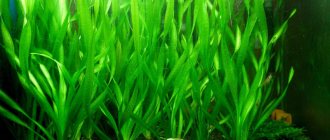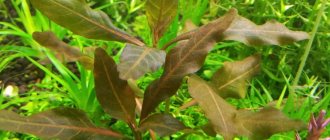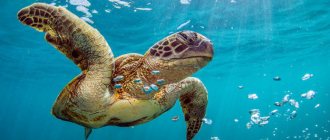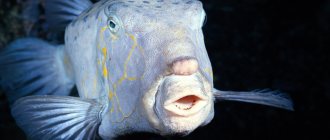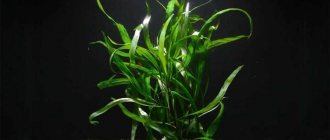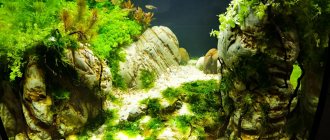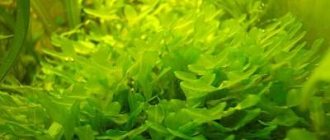Aquarium plants are an important component of an artificial reservoir. In addition to the decorative function, they play many other important roles: they absorb carbon dioxide and release oxygen, serve as a habitat for beneficial bacteria that process nitrogen compounds, provide shelter for shy aquatic organisms, and are necessary for the nutrition and reproduction of some species of fish. In an aquarium devoid of greenery, it is difficult to maintain biological balance; it grows algae faster. Therefore, it is important to have living representatives of aquatic flora in the reservoir.
Duckweed
Duckweed is a small plant that floats on the surface of the aquarium. The leaves are small, convex at the bottom and filled with air chambers, which ensures the buoyancy of the duckweed. The leaves are solitary, bright, green, oval in shape. Stem up to 2 mm long. Duckweed is a perennial, light-loving plant.
Duckweed can be used as decoration for an aquarium and as an additive to the diet of fish. It is also used to create shadows. Sometimes duckweed gets into the aquarium completely by accident, for example, with other plants or with live food.
Duckweed is unpretentious and gets along well in new conditions. For this plant, it does not matter what quality of water and temperature. It is enough for duckweed if the aquarium temperature is between 12 and 30 degrees. It is a floating plant and requires plenty of overhead light to grow, as well as no strong currents.
Some types of fish (angelfish, goldfish, other viviparous fish) eat duckweed. You can also make dry food from it. The leaves are collected, dried and ground. This food is nutritious and contains many vitamins. Other fish may use duckweed as cover for spawning.
Duckweed reproduces with the help of daughter plants. They are formed along the edges of the leaf plate. The reproduction process occurs very quickly. Let's look at duckweed as a plant that easily takes root in an aquarium, its types with photos and names.
There are several types of duckweed:
- Lesser duckweed - the most common type. The leaves are elliptical in shape, yellowish-green in color. The leaves reach a length of up to 4.5 mm.
- Duckweed multi-rooted - has round leaves up to 6 mm long. The back side of the leaves is purple. This type of duckweed has a bunch of roots coming off each leaf, hence the name.
- Duckweed trilobed - lives in the water column and rises to the surface only during the flowering period. The length of the leaves reaches 1 cm. Duckweed leaves form balls that float in the water. This type of duckweed is rare.
- Duckweed humpback - occurs quite often. The leaves are convex and glossy, 5-7 mm long. This type of duckweed is the fastest growing.
How to place plants in an aquarium
As you understand, it is better to plant large and dense plants near the back wall so that they do not block the view of the aquarium. Smaller plants are planted on the sides of the aquarium and in its middle. Well, the smallest plants are planted in the foreground. It is better to plant tall plants along the edges, or individually in the center of the aquarium. We place light-loving plants under lighting lamps.
Vallisneria
Vallisneria is a fairly popular plant. There are many types of Vallisneria. Only three species are used for aquariums - spiral, giant and dwarf Vallisneria.
Conditions for growing Vallisneria:
- temperature in the range of 22-28 degrees;
- water should have a hardness of up to 8 mg-eq/l;
- Water pH - from 6 to 7.5;
- every week it is necessary to change 1/4 of the water from the volume of the aquarium;
- plant in slightly silted soil, which contains small pebbles, or in river sand;
- When growing spiral and/or dwarf Vallisneria, the soil should be 3-4 cm thick. When growing giant vallisneria, the soil should be 7-8 cm thick;
- lighting - 0.5 W per liter.
This plant looks good in the corners of an aquarium or in the background.
It grows very quickly. Vallisneria reaches 70 cm in length, and giant Vallisneria - up to 2 meters. If the plant reaches the top of the aquarium, it spreads along the surface of the aquarium. But you can’t shorten Vallisneria , because the tips of the leaves will begin to rot! If the plant has grown too much, it is recommended to thin it out. In this case, you need to remove the daughter plants.
Important! If you are planning to treat fish with preparations containing copper, Vallisneria must be removed from the aquarium, otherwise the plant will die. Vallisneria also dies if rust or the antibiotic Bicillin-5 is present in the aquarium.
Elodea
Elodea is a plant of the watercolor family. Homeland - North America. Grows in rivers, lakes, ponds, swamps. Used in an aquarium for decorative purposes.
Elodea grows quickly, shoots can reach 2 meters. The shoots can be trimmed to the length that the aquarium allows. Elodea roots are thin, brittle and long. The stem is branched. The leaves are linear-lanceolate, up to 1 cm long, bright green, without petioles.
Elodea is a dioecious plant. Both males and females need to be raised in an aquarium. The peduncle of elodea is long and reaches the surface of the water. Flowers are small.
Growing conditions:
- water hardness in the range from 2 to 14 mEq/l;
- water acidity - from 5.5 to 8 pH;
- temperature - from 16 to 24 degrees;
- the plant needs light, although shading is also possible;
- daylight hours - 12 hours;
- aquarium volume - any;
- any soil, but it is easier to keep the plant free-floating.
Elodea reproduces only vegetatively - by shoot cuttings. In order for elodea to take root well and quickly in a new place, the cuttings must be at least 20 cm long.
Did you know? The most expensive aquarium on the planet is the Golden Dragon Aquarium. Its cost is 5 million dollars. The aquarium is made of gold. Its designer is Stuart Hughes.
Hornwort
Hornwort is a common and unpretentious plant. Hornwort has a green thin stem and needle-shaped leaves. This plant is only suitable for underwater life. Hornwort has no roots and does not need to be planted in the ground. He just floats in the water. If this is not convenient, then the hornwort can be attached with stones or driftwood.
Hornwort acts as a filter in an aquarium. This plant enriches water with oxygen and removes nitrates from it. Hornwort also works on the principle of a mechanical filter - it retains suspended matter. If a coating of turbidity forms on the plant, it can be washed under running water.
Hornwort grows at temperatures from 20 to 30 degrees. If the temperature is closer to 30 degrees, then the hornwort can accelerate its growth and grow up to 20 cm in a week.
Hornwort needs bright lighting - approximately 0.4-0.5 W per liter. But he doesn't like direct sunlight. It is recommended that there be 12 hours of daylight.
When changing water by 1/4 of the volume at intervals of once a week, hornwort does not need mineral fertilizing. It reproduces only by dividing the stem. Even if you have a very small piece of stem, you can grow a whole plant from it.
At what price can I buy aquarium plants, catalogs
The price of aquarium plants can vary significantly depending on the region. If we take Moscow, for example, then hygrophila can be purchased for 3,200 rubles, but kabomba for only 170 rubles. The price of Vallisneria ranges from 1200 rubles. The aquarium plant Cryptocoryne is valued at about the same. The cost of Ludwigia is 170 rubles. Valisneria is valued at 250 rubles.
Online store catalogs can be easily accessed by typing the appropriate query for your region in any search engine.
Limnobium
Limnobium shoots is native to tropical and subtropical countries of North and South America. This plant consists of glossy leaves floating on the surface of the water on short cuttings. The leaves are no more than 2-3 centimeters in diameter. This algae is used not only as decoration, but also as a shade in the aquarium. Under favorable conditions, it is capable of completely covering the surface of the aquarium, so it is recommended to remove excess limnobium.
Limnobium does not require special temperature conditions. It is kept in both tropical and moderately warm aquariums. Recommended water temperature is 20-30 °C. In cool water, Limnobium slows down its growth and decreases in size. The algae grows better in soft water; the hardness should be no more than 10-12 mEq/l.
Like most floating algae, Limnobium requires strong light, but for some time it can live in shade. Use fluorescent lamps with a power of 2 W per 1 sq. for lighting. dm. When using incandescent lamps, the plant may get burned.
Limnobium does not need to be fertilized with mineral fertilizers. It multiplies very quickly by forming daughter shoots at the ends of the lateral shoots, which can be separated after the formation of three leaves and a root.
Algae Fertilizer
Yes, that's fertilizer. At the pet market, not only fish and algae for the aquarium are on sale, but also fertilizers.
When vegetation does not receive all the mineral fertilizers, it does not grow or withers, the same can be said about algae. The Tetra line includes fertilizers that contain a full range of minerals necessary for algae. Moreover, there are different forms of fertilizer - these are tablets, powders and even liquids. Read the instructions carefully and follow the information on feeding plants.
Riccia
Riccia grows in all moderately warm areas of the planet. This is bright green openwork moss floating on the surface of the aquarium. Riccia is often used by experienced aquarists as a natural substrate for fish spawning and as a hiding place for fry. It is also used as a shade.
Riccia grows in a tropical and moderately warm aquarium at a temperature of 22-26 ° C. May die or stop growing at temperatures below 20 degrees Celsius. The water should be soft, neutral or slightly alkaline, since growth slows down with hard water. It is also recommended to regularly change 1/5 of the water.
Use good lighting to grow Riccia, as in low light it will disintegrate and will not create islands. It should be remembered that when direct rays of the sun hit it, it is better to shade Riccia. Use standard fluorescent lamps for lighting, but do not use incandescent lamps.
Algae have enough substances that enter the aquarium with fish or fresh water, so there is no need to feed Riccia separately. It grows very quickly, from a small Riccia thallus it spreads throughout the entire aquarium in a short time.
Did you know? The largest home aquarium is in the UK. It is located in the basement of one of the houses and has room dimensions of 4 x 3.85 x 2.13 m. Exotic fish from the Amazon and Congo live in it.
Java moss
Java moss is native to Southeast Asia. This is an interweaving of thin dark green threads that are tightly attached to uneven stones and snags. If moss is left undisturbed for a long time, it forms attractive thickets on objects in the aquarium. It is used as a place for fish spawning. Java moss is an unpretentious plant that grows slowly throughout the year.
The ideal temperature for moss should be 24-28 °C. If the temperature is lower, the moss stops growing. The hardness and reaction of the water do not matter to him, since moss grows in any water. It should be remembered that the water must be clear, since in cloudy water a plaque builds up on the algae, which disrupts the nutrition of the plant and worsens its appearance. Water changes are very often not required.
The type and intensity of lighting in the aquarium also do not play a role. Moss can grow for a long time even in minimal light, but in bright light it grows faster, acquires a rich green color and begins to branch in threads.
Moss grows well if placed on the bottom of an aquarium without soil. Reproduction takes place vegetatively; to do this, simply put a small piece of moss in the water. It can also be grown in a greenhouse with high humidity. Sometimes moss peels off from the stones and snags on which it grows, rises in the water and at the same time grows both in the water and in the open air.
Types of herbs
There is a huge selection of herbs for the aquarium. As a rule, they are selected based on the following conditions. First of all, the choice of plants is influenced by the size of the aquarium. If it is small, then you have to limit yourself and purchase algae that will fit perfectly into the aquatic landscape. Some plants are quite capricious and not suitable for beginners. Some of the most popular species include the following aquarium grass names: dwarf anubias, hornwort, echinodorus, eleocharis, the rather attractive hemianthus and an interesting plant called Java moss.
Cryptocoryne
It was brought by aquarists from Southeast Asia, where it lives in the coastal zones of numerous islands, small rivers and ponds with stagnant water. Essentially, these are marsh plants that grow underwater and bloom in the air.
Cryptocoryne , they can be identified solely by the spathe, which consists of a chamber for the inflorescence tube and petal.
Cryptocorynes are very unpretentious. The temperature should be 24-28 °C, the water should be neutral in hardness and acidity. Aquarists recommend changing up to 1/3 of the water in the aquarium weekly for normal growth.
Keep the light not very bright, diffused. We should not forget that the soil must contain nutrient substrates, which consist of complex fertilizers. Also, the soil should be approximately the same temperature as the water, since cool soil will slow down algae growth.
Cryptocorynes do not like replanting, since leaves will appear in a new place only after a few months, even if the care is correct. Cryptocorynes reproduce by shoots that may be located in the substrate. A small leaf formed at the end of the shoot eventually grows into a small bush. After 5-6 leaves are formed on it, and the age is several weeks, Cryptocoryne can be transplanted.
There are a number of species of this plant for the aquarium; below you will see their photos with names:
- Cryptocoryne undulata;
- Cryptocoryne Thwaiteza;
- Cryptocoryne cordate;
- Cryptocoryne spiralis;
- Cryptocoryne related;
- Cryptocoryne purpurea;
- Cryptocoryne ciliata;
- Cryptocoryne pontederifolia;
- Cryptocoryne parva;
- small cryptocoryne;
- Cryptocoryne reverse spiral;
- Cryptocoryne Neville;
- Griffith's Cryptocoryne;
- Beckett's cryptocoryne;
- Cryptocoryne aponoghetonolifolia;
- Cryptocoryne Wendt;
- Cryptocoryne Walker;
- Cryptocoryne Albida.
What are they needed for?
As already mentioned, the grass in the aquarium plays the role of food for small fish, as well as feeding for large ones. In addition, it maintains the aquatic system in its natural state. The role of grass is also important from an aesthetic point of view. There are many types of algae that can decorate any aquarium. With their help, you can create a magnificent landscape, as much as the owner’s imagination allows.
However, one should take into account the fact that some fish are not able to coexist with aquarium plants. For example, astronotus and pterygoplichths eat them at such a speed that it makes no sense to plant new herbs every time. In addition, having large fish in a small aquarium, the owners have to create an enhanced water purification system, which also causes the plants to die.
Echinodorus
Echinodorus is a perennial marsh grass; some species can also grow on land. The absence of a stem is the main feature of all species of Echinodorus, even large representatives.
The leaves of the plant appear directly from the rhizome, from which thickenings (rhisomes) grow, on which buds then grow. The usual method of reproduction is budding.
The leaves of Echinodorus are very elongated and very dense. The shape of the leaves is spear-shaped, pointed or oval on top, and also elliptical.
Echinodorus is a flowering algae; a long peduncle ending in an inflorescence grows directly from the leaves. Branches may form on the peduncle and leaves may grow. Roots are already growing from them, and the daughter plant is separated from the mother plant. This is also a characteristic method of propagation of Echinodorus along with the root.
Echinodorus are usually kept in deep aquariums, since their height can reach 60 cm. Grass is planted in the center of the aquarium closer to the back side.
Coarse sand or fine gravel is used as soil. It would also be a good idea to add river silt to the soil. The ideal temperature would be 18-26 degrees Celsius, water hardness - 5-10 mEq/l. The acid balance should be neutral. Such conditions are suitable for most decorative species, although there are particularities for certain species.
Different species and hybrids of Echinodorus are being created to this day. Next you can see the names of the species and varieties of these algae with pictures:
- Echinodorus angustifolia;
- Echinodorus cordifolia Tropica Marble Queen;
- Echinodorus tender;
- Echinodorus osiris;
- Echinodorus Blecher, or yarrow;
- Echinodorus rubin;
- Echinodorus Kleiner Bar;
- Echinodorus rose;
- Echinodorus osiris doppel mouth;
- Echinodorus Jungelstar;
- Echinodorus Amazonis.
Why does grass spoil?
This question very often worries aquarium owners. There are many reasons for this problem. Most often, algae rot due to poor soil, poor in microelements, as well as in the case of too many fish, which results in the release of a lot of carbon dioxide. Plants do not like poor lighting and hard, poor-quality water. If acidification of the soil occurs, those algae that have a rhizome may suffer. Therefore, before planting aquarium grass with seeds or rhizomes, you should take care of the quality of the soil.
Almost all algae require trace elements such as magnesium, iron, nitrogen, potassium and calcium. For example, due to a lack of magnesium, brown spots appear on plant leaves, and when there is a lack of nitrogen, it turns yellow. In addition, a lack of potassium or iron also leads to yellowing. If the leaves fall off, then most likely there is an acute lack of phosphates in the aquarium. You can also determine their deficiency by looking at muddy water.
Why does the grass in the aquarium turn brown? To prevent soil acidification, you should reduce the amount of sand and fine gravel. However, the soil underneath must be nutritious enough for the plants to thrive. Sometimes too many fish kill the algae. As a result of their vital activity, huge amounts of ammonium and ammonia are released. This, in turn, negatively affects the aquarium ecosystem.
